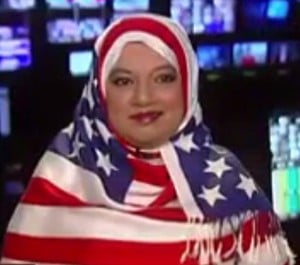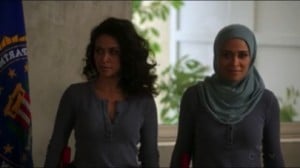There are certain stories newspapers here in the U.K. love. Anything that can be classed as “a waste of taxpayer’s money” is guaranteed to find its way into print, even more so if it involves something “frivolous” like artwork. And, as has been noticed previously at MMW, the media also has a fascination with Muslim women’s clothing.
So if there is a story that combines both these fixations, it’s bound to generate a lot of print.

Tower Hamlets Council has recently put forward a proposal to build two “Hijab Gates” (pictured at left) at either end of Brick Lane (also known as “Banglatown”). The gates will cost £1.85 million to build, all of which will come from public funds. “Hijab-gate,” anyone?*
In such difficult economic times, it is expected that such expenditure be questioned. However, looking at the media reports, it would appear that money isn’t the biggest issue. Even the aesthetics of the design are not the main cause of controversy.
What is really causing consternation is the choice of Muslim symbol, even in an area with a sizable Muslim population. The Daily Express thunders that such plans are “Pandering to Islam.” Note the usage of the word Islam rather than Muslims–all the better to give the impression of a monolithic entity.
But Tower Hamlets Council is quoted in this piece and others as stating that the headscarf is not solely a Muslim garment but one worn by many different communities.
Next we hear from broadcaster John Nicolson. He is in the piece to supply the other trope much beloved by journalists, that of Muslims being given/seeking preferential treatment to other religious groups:
“They’d never dream of crucifix-inspired gates, nor should they, so why an arch that is Islamic and representing a specifically conservative form of Islam?”
Actually, a pedantic person could claim that the so-called “Hijab Gates” look more like the bandanas worn by some Plymouth Brethren women, but that’s not nearly as juicy as a “Muslims try to take over everything, everywhere” story.
On to the Daily Mail, with includes the phrase “waste of taxpayer’s money” within the headline. It also accuses the project of being “culturally insensitive.” However from the article itself, it’s not actually clear who the project is insensitive to. Firstly, we have the modern artist Tracy Emin decrying that taxpayer’s money could be better spent, which is ironic considering, that she recently proclaimed she would move to France if U.K. tax levels increased.
Next, some criticism of the hijab as a public sculpture, according to local artist Brad Lochore, using a hijab is giving a wrong sign because it means “repression and domination” and “territorialization for one minority group.”
Any chance of a Muslim point of view? No, instead we hear from local resident and chair of Save Britain’s Heritage, Will Palin, who claims the Hijab Gates are unrepresentative of the area’s diversity.
The Daily Telegraph piece probes the issues of cultural insensitivity further. The writer, James Hall, declares that it is wrong for a symbol so closely associated with Bangladeshi Muslims to be used, because Brick Lane is more than just curry houses (inferring that all Bangladeshis can produce is food). To him, hipster vintage shops and locations associated with East End gangsters are far more interesting and worthy of cultural celebration.
All three of these newspapers could be described as politically and socially conservative. Would a more left wing newspaper provide a more nuanced approach? Would it actually bother interviewing any Muslims?
Well, yes it did, but it didn’t actually bother naming them. Tracy Emin, John Nicolson and Will Palin are all quoted and named in The Guardian’s piece, as is Sammy Minzly, a bagel shop owner. The two Muslim women interviewed, both of whom are critical of the plan, describing it as pushing a stereotypical version of Islam and creating tension. They are referred to as “a local Muslim woman” and “Another, a headscarf wearer.”
To not even name the Muslim women just smacks of a lazy Appeal to Melanin, rather then any real concern for what Muslims think. The mere use of the terminology “a headscarf wearer” is so dehumanizing, it is unbelievable that a supposedly politically correct publication could think of using it.
So far I’ve discussed what has been said in all four articles. However, the real issues is not the words on the page, but what they imply, which is that Muslim symbols and public displays of Muslim identity are bad and provocative, even in an area with a large Muslim population. Muslims can provide some background color in the name of diversity and cook nice food for others to eat, but move out of those boundaries and howls of protest will ensue. Muslims cannot celebrate their culture without being accused of imposing it on others. Muslims and Muslim culture can never been seen as positive or even benign—we’re always portrayed as a threat to the established order.
*Editor’s Note: For readers not familiar with 1970s U.S. political history, “-gate” is a suffix used to denote a political scandal. Its use originated with the Watergate scandal during the Nixon administration.











